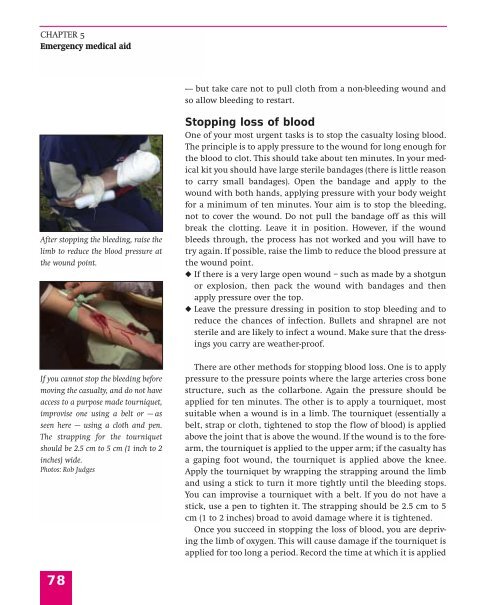Live News - A Survival Guide - International Federation of Journalists
Live News - A Survival Guide - International Federation of Journalists
Live News - A Survival Guide - International Federation of Journalists
- No tags were found...
Create successful ePaper yourself
Turn your PDF publications into a flip-book with our unique Google optimized e-Paper software.
CHAPTER 5Emergency medical aid-— but take care not to pull cloth from a non-bleeding wound andso allow bleeding to restart.After stopping the bleeding, raise thelimb to reduce the blood pressure atthe wound point.If you cannot stop the bleeding beforemoving the casualty, and do not haveaccess to a purpose made tourniquet,improvise one using a belt or — asseen here — using a cloth and pen.The strapping for the tourniquetshould be 2.5 cm to 5 cm (1 inch to 2inches) wide.Photos: Rob JudgesStopping loss <strong>of</strong> bloodOne <strong>of</strong> your most urgent tasks is to stop the casualty losing blood.The principle is to apply pressure to the wound for long enough forthe blood to clot. This should take about ten minutes. In your medicalkit you should have large sterile bandages (there is little reasonto carry small bandages). Open the bandage and apply to thewound with both hands, applying pressure with your body weightfor a minimum <strong>of</strong> ten minutes. Your aim is to stop the bleeding,not to cover the wound. Do not pull the bandage <strong>of</strong>f as this willbreak the clotting. Leave it in position. However, if the woundbleeds through, the process has not worked and you will have totry again. If possible, raise the limb to reduce the blood pressure atthe wound point.◆ If there is a very large open wound – such as made by a shotgunor explosion, then pack the wound with bandages and thenapply pressure over the top.◆ Leave the pressure dressing in position to stop bleeding and toreduce the chances <strong>of</strong> infection. Bullets and shrapnel are notsterile and are likely to infect a wound. Make sure that the dressingsyou carry are weather-pro<strong>of</strong>.There are other methods for stopping blood loss. One is to applypressure to the pressure points where the large arteries cross bonestructure, such as the collarbone. Again the pressure should beapplied for ten minutes. The other is to apply a tourniquet, mostsuitable when a wound is in a limb. The tourniquet (essentially abelt, strap or cloth, tightened to stop the flow <strong>of</strong> blood) is appliedabove the joint that is above the wound. If the wound is to the forearm,the tourniquet is applied to the upper arm; if the casualty hasa gaping foot wound, the tourniquet is applied above the knee.Apply the tourniquet by wrapping the strapping around the limband using a stick to turn it more tightly until the bleeding stops.You can improvise a tourniquet with a belt. If you do not have astick, use a pen to tighten it. The strapping should be 2.5 cm to 5cm (1 to 2 inches) broad to avoid damage where it is tightened.Once you succeed in stopping the loss <strong>of</strong> blood, you are deprivingthe limb <strong>of</strong> oxygen. This will cause damage if the tourniquet isapplied for too long a period. Record the time at which it is applied78
















